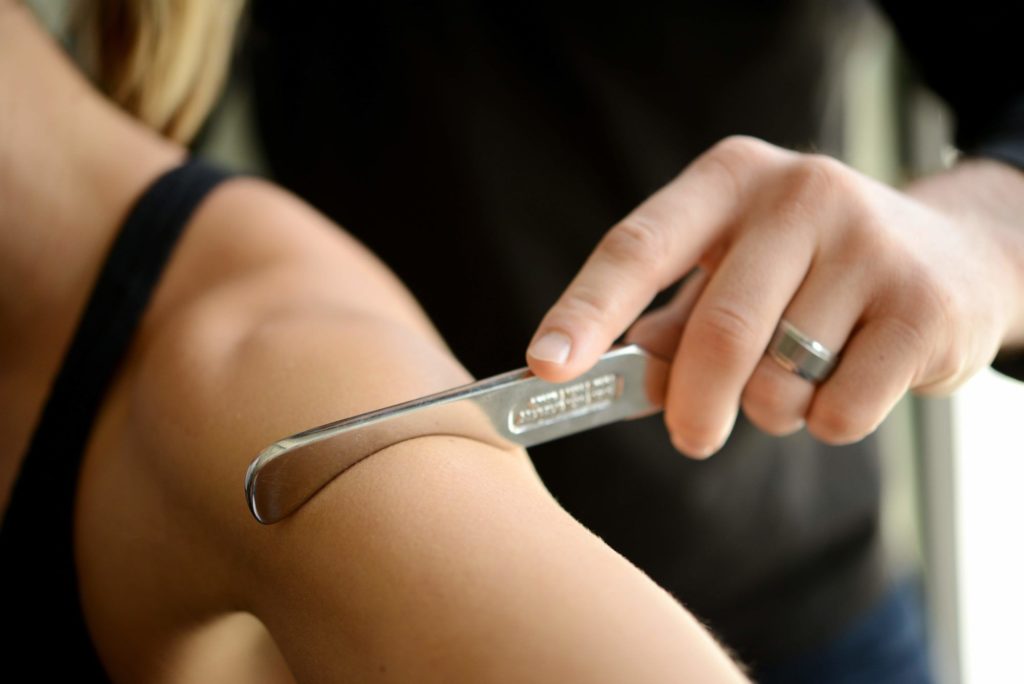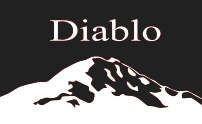
Graston Technique / Instrument Assisted Soft Tissue Mobilization (IASTM)
Straining a muscle or pulling a ligament or tendon often causes trauma to the affected tissues, resulting in pain, scar tissue build up, fascia restrictions, and dysfunctional movement. Diablo Physical Therapy offers the Graston Technique®, a form of instrument-assisted soft tissue mobilization (IASTM), to treat soft tissue dysfunction and restore range of motion.
The Graston Technique uses a set of six stainless steel instruments that are moved against the skin using specialized massage techniques. The instruments have unique edges and angles. Physical therapists use these instruments to both detect and treat injured soft tissue.
The Graston Technique involves several steps. First, the instruments are used in conjunction with an evaluation of movement and function to detect restrictions, scar tissue, or soft tissue lesions. The instruments are “combed” over the affected area and help the physical therapist to locate abnormal tissue.
Once identified, the treatment commences, starting with a brief warm-up exercise. The Graston instruments and Graston Technique massage are then used to treat the area. The therapy improves blood flow to the affected area and promotes healing. Instrument-assisted soft tissue mobilization therapy helps to break down scar tissue and rearrange connective tissues, which lead to reduced pain and increased function. Finally, the treatment concludes with stretching and strengthening, and when subacute inflammation is involved, icing.
The Graston Technique is an evidence-based form of IASTM that is effective at treating a variety of conditions including:
- Ankle pain
- Knee pain
- Shoulder pain
- Joint pain
- Muscle knots
- Tendinitis
- Carpal Tunnel Syndrome
- Back pain
- Neck pain
- Shin splints
- Trigger finger
- Fibromyalgia
- Myofascial Pain Syndromes
- Tennis elbow
- Golfer’s elbow
- Plantar Fasciitis
- Joint replacement post-surgical treatments
- Post-surgical scar tissue treatments
- Central and/or peripheral sensitization
- Post-mastectomy and c-section scarring
Benefits of the Graston Technique include:
- Faster treatment times
- Faster recovery times
- Less reliance on medications
- Reduced pain
- Increased function
- Non invasive
Most patients undergo one-to-two treatments per week over the course of about four or five weeks and experience positive results by the third of fourth treatment. Those with more chronic conditions typically receive six to twelve treatments.
Graston Technique Tips
To prepare for Graston Technique therapy sessions, it’s helpful to know what to expect. You’ll likely be asked to warm up on a treadmill or stationary bike, which warms up your muscles and tissues before treatment. Thus, it’s not a bad idea to wear comfortable clothing suitable for those activities.
The treatment itself is non invasive. However, you may experience some slight discomfort, just as you would when undergoing deep tissue massage. If the treatment becomes too uncomfortable, let the physical therapist know.
After the treatment, some bruising and soreness are to be expected and are not cause for alarm. Stretching and icing the affected area for about 20 minutes after the treatment can help to ease any soreness you may feel.
How can Diablo Physical Therapy help with Recovery?
Diablo Physical Therapy offers the Graston Technique along with other types of therapies, enabling us to develop a treatment plan that best addresses your condition and objectives. We have certified Graston Technique physical therapists on staff ready to help ease your pain and get you back on the track to recovery.
Are you a good candidate for Graston Technique physical therapy? Whether you’re currently experiencing pain or would like to prevent it, scheduling a consultation with a physical therapist is a great choice for:
- Carpal tunnel treatment
- Tendinitis treatment
- Fibromyalgia pain treatment
- Plantar fasciitis pain relief
- Myofascial pain relief
- Joint pain relief
- Back or neck pain relief
- General muscle pain relief
Request a Personalized Care Plan with Pricing
FAQs about Graston Technique
What type of instruments are used in the Graston Technique?
The Graston Technique uses a set of instruments made of stainless steel. They are handheld instruments with rounded angles and curves. Each instrument has a treatment edge. Some are convex, others are concave. Some have a single bevel, others have a double bevel. Curves vary in size, allowing the physical therapist to select instruments for larger or smaller body parts. The largest instrument looks similar to handlebars and is used for treating large areas. The instruments are not sharp and you won’t get cut. The instruments are designed to catch any restrictions in the muscles and fascia when they are rubbed along your body.
Will the Graston Technique hurt?
No. It is a non-invasive treatment that is not intended to be painful or cause excessive bruising. You may experience some minor discomfort or some bruising. Your physical therapist can adjust the intensity of the treatment as needed, so don’t be shy about speaking up if you experience any pain.
Are there any restrictions on activities I can perform while undergoing treatment?
This will depend on your condition. Once you’ve progressed passed a certain point, your physical therapist will likely encourage you to resume certain activities and exercises, with modifications and at a level where you remain pain free. Your physical therapist will be using the Graston Technique alongside other therapies to help you achieve the desired outcome.
Is instrument-assisted soft tissue mobilization effective?
According to Graston Technique Movement Center, the Graston Technique “…has had positive outcomes in 75-90 percent of all conditions treated. It is equally effective in restoring function to acute and chronic injuries, pre- and post-surgical patients and maintaining optimal range of motion.”
A systemic review published in Physical Therapy Reviews, The effects of instrument-assisted soft tissue mobilization compared to other interventions on pain and function: a systematic review, examined seven studies and concluded that “IASTM is an effective treatment intervention for reducing pain and improving function in less than a three-month period.”
Consult with a Physical Therapist to Learn More
Ready to experience freedom from pain? Our friendly, knowledgeable team is here to help.

Graston Technique / Instrument Assisted Soft Tissue Mobilization (IASTM)
Straining a muscle or pulling a ligament or tendon often causes trauma to the affected tissues, resulting in pain, scar tissue build up, fascia restrictions, and dysfunctional movement. Diablo Physical Therapy offers the Graston Technique®, a form of instrument-assisted soft tissue mobilization (IASTM), to treat soft tissue dysfunction and restore range of motion.
The Graston Technique uses a set of six stainless steel instruments that are moved against the skin using specialized massage techniques. The instruments have unique edges and angles. Physical therapists use these instruments to both detect and treat injured soft tissue.
The Graston Technique involves several steps. First, the instruments are used in conjunction with an evaluation of movement and function to detect restrictions, scar tissue, or soft tissue lesions. The instruments are “combed” over the affected area and help the physical therapist to locate abnormal tissue.
Once identified, the treatment commences, starting with a brief warm-up exercise. The Graston instruments and Graston Technique massage are then used to treat the area. The therapy improves blood flow to the affected area and promotes healing. Instrument-assisted soft tissue mobilization therapy helps to break down scar tissue and rearrange connective tissues, which lead to reduced pain and increased function. Finally, the treatment concludes with stretching and strengthening, and when subacute inflammation is involved, icing.
The Graston Technique is an evidence-based form of IASTM that is effective at treating a variety of conditions including:
- Ankle pain
- Knee pain
- Shoulder pain
- Joint pain
- Muscle knots
- Tendinitis
- Carpal Tunnel Syndrome
- Back pain
- Neck pain
- Shin splints
- Trigger finger
- Fibromyalgia
- Myofascial Pain Syndromes
- Tennis elbow
- Golfer’s elbow
- Plantar Fasciitis
- Joint replacement post-surgical treatments
- Post-surgical scar tissue treatments
- Central and/or peripheral sensitization
- Post-mastectomy and c-section scarring
Benefits of the Graston Technique include:
- Faster treatment times
- Faster recovery times
- Less reliance on medications
- Reduced pain
- Increased function
- Non invasive
Most patients undergo one-to-two treatments per week over the course of about four or five weeks and experience positive results by the third of fourth treatment. Those with more chronic conditions typically receive six to twelve treatments.
Graston Technique Tips
To prepare for Graston Technique therapy sessions, it’s helpful to know what to expect. You’ll likely be asked to warm up on a treadmill or stationary bike, which warms up your muscles and tissues before treatment. Thus, it’s not a bad idea to wear comfortable clothing suitable for those activities.
The treatment itself is non invasive. However, you may experience some slight discomfort, just as you would when undergoing deep tissue massage. If the treatment becomes too uncomfortable, let the physical therapist know.
After the treatment, some bruising and soreness are to be expected and are not cause for alarm. Stretching and icing the affected area for about 20 minutes after the treatment can help to ease any soreness you may feel.
How can Diablo Physical Therapy help with Recovery?
Diablo Physical Therapy offers the Graston Technique along with other types of therapies, enabling us to develop a treatment plan that best addresses your condition and objectives. We have certified Graston Technique physical therapists on staff ready to help ease your pain and get you back on the track to recovery.
Are you a good candidate for Graston Technique physical therapy? Whether you’re currently experiencing pain or would like to prevent it, scheduling a consultation with a physical therapist is a great choice for:
- Carpal tunnel treatment
- Tendinitis treatment
- Fibromyalgia pain treatment
- Plantar fasciitis pain relief
- Myofascial pain relief
- Joint pain relief
- Back or neck pain relief
- General muscle pain relief
Request a Personalized Care Plan with Pricing
FAQs about Graston Technique
What type of instruments are used in the Graston Technique?
The Graston Technique uses a set of instruments made of stainless steel. They are handheld instruments with rounded angles and curves. Each instrument has a treatment edge. Some are convex, others are concave. Some have a single bevel, others have a double bevel. Curves vary in size, allowing the physical therapist to select instruments for larger or smaller body parts. The largest instrument looks similar to handlebars and is used for treating large areas. The instruments are not sharp and you won’t get cut. The instruments are designed to catch any restrictions in the muscles and fascia when they are rubbed along your body.
Will the Graston Technique hurt?
No. It is a non-invasive treatment that is not intended to be painful or cause excessive bruising. You may experience some minor discomfort or some bruising. Your physical therapist can adjust the intensity of the treatment as needed, so don’t be shy about speaking up if you experience any pain.
Are there any restrictions on activities I can perform while undergoing treatment?
This will depend on your condition. Once you’ve progressed passed a certain point, your physical therapist will likely encourage you to resume certain activities and exercises, with modifications and at a level where you remain pain free. Your physical therapist will be using the Graston Technique alongside other therapies to help you achieve the desired outcome.
Is instrument-assisted soft tissue mobilization effective?
According to Graston Technique Movement Center, the Graston Technique “…has had positive outcomes in 75-90 percent of all conditions treated. It is equally effective in restoring function to acute and chronic injuries, pre- and post-surgical patients and maintaining optimal range of motion.”
A systemic review published in Physical Therapy Reviews, The effects of instrument-assisted soft tissue mobilization compared to other interventions on pain and function: a systematic review, examined seven studies and concluded that “IASTM is an effective treatment intervention for reducing pain and improving function in less than a three-month period.”
Consult with a Physical Therapist to Learn More
Ready to experience freedom from pain? Our friendly, knowledgeable team is here to help.
